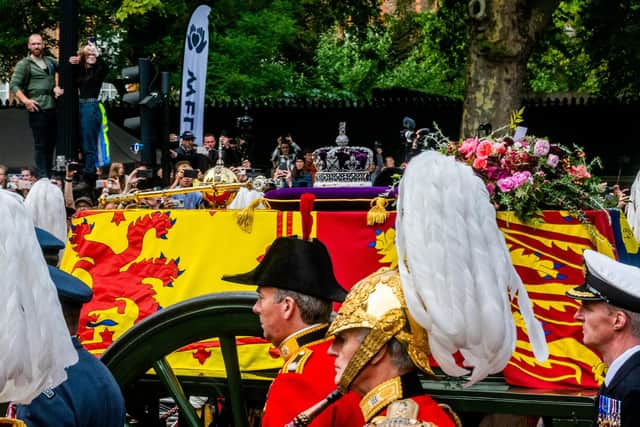How the Queen's funeral showed that indeed we did meet again following the pandemic - Jayne Dowle
By leaving home in Barnsley just after 2am, my teenage daughter and I had managed to find an excellent vantage point on Horse Guards Parade, just in front of the Guards War Division memorial, which commemorates the Guardsmen who died during the two World Wars and in service of their country since 1918.
It was a day, obviously, given to many reflections upon mortality. As I gazed out at the crowd, I counted many of our number as visitors from overseas. We were immediately positioned next to a sprawling French family, an elegant young couple who spoke Spanish, and two taciturn Scots, with several Americans in front of us, who annoyingly kept needing to exit, either for coffee or the loo.
Advertisement
Hide AdAdvertisement
Hide AdI thought about why they were all here, and how we had all got here, especially as planes continued to fly overhead, even during the funeral service. I considered the fact that even a year ago, when lockdown had only been fully lifted for two months to the day – since July 19 - we probably wouldn’t have even been in London, let alone shoved cheek by jowl for hours with a load of strangers.


Those of us who might have braved the new freedoms would probably have been wearing masks and feeling slightly anxious, even in the open air.
And yet, as my daughter and I watched the BBC coverage of the Westminster Abbey pews filling up on her mobile phone, another man nearby, a former Duke of Wellington’s regiment officer from Dorset with his wife and children, looked over our shoulders and asked us, “excuse me, who’s that balding man sitting there, his face looks familiar, can’t quite place him?”.
I replied that actually, it was Sir Chris Whitty, the Chief Medical Officer for England, and not so long ago, a nightly presence on our television screens with his slides, graphs and charts.
Advertisement
Hide AdAdvertisement
Hide Ad“How soon we forget,” I said, to try and make the poor chap feel a little better about entirely blanking out a key public figure who once possessed such tremendous power over our personal freedoms.
And how soon we embrace life, I added silently. During the service, when old soldiers openly shed tears and my own eyes welled up at the first line of that fine Victorian hymn “The Day Thou Gave Us, Lord, Is Ended”, I was struck by our human resilience, even in the aftermath of the biggest pandemic in living history.
With the gravelled expanse of Horse Guards Parade behind us, at the start of our vigil we had plenty of space to spread out. By the end, however, when the whisper went round that the Queen’s coffin was about to pass by on the gun carriage, everyone surged to the front of the barriers.
There was literally no space to move, even to wiggle our aching feet. Whatever became of social distancing, I wondered as we all squashed in together, with many ‘sorrys’ and ‘scusis’.
Advertisement
Hide AdAdvertisement
Hide AdAs the Archbishop of Canterbury reminded us during the funeral service, Her Majesty did assure us that “we will meet again” in her speech at the start of the pandemic. The sermon was received by a 2,000-strong congregation who certainly would not have assembled in such number in those terrible days of socially-distanced funerals - even the Queen herself had to mourn her dear husband, the Duke of Edinburgh, alone in April 2021.
Perhaps some of us were unsure that we would. And many of us did not; we lost loved ones during those long 19 months that strict travel, visiting and mixing restrictions were in place, including my own children, whose father died in a Surrey hospice from a brain tumour, and with Covid on his death certificate, in March 2021.
The unprecedented public support for this funeral however, and the coming together of so many people, not just on Monday, but in the days preceding, when hundreds of thousands queued for hours to file past the coffin in Westminster Hall and pay their respects, reminds us that in death, we are also in life.
Horse Guards Parade was silent and solemn as the clock struck 11am and the funeral commenced. An hour or so later, however, the feeling that charged through the crowd was almost one of elation. So many of us, strangers until that moment, had come together, shared an unforgettable and unrepeatable experience and had celebrated the fact that yes, we were alive and here to bear witness.
We did, after all, meet again.